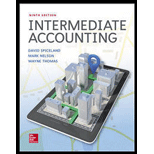
INTERMEDIATE ACCOUNTING (LL) W/CONNECT
9th Edition
ISBN: 9781260679694
Author: SPICELAND
Publisher: MCG
expand_more
expand_more
format_list_bulleted
Question
Chapter 7, Problem 7.25E
To determine
The accounts receivable turnover ratio determines the efficiency of a company to use its assets and issue the credit to the customers and collects the funds from them. The accounts receivable turnover is determined by dividing the credit sales by the average accounts receivable of that accounting period.
Average Collection Period:
The average collection period refers to the average number of days which a company takes to collect the accounts receivable. The average collection period is determined by dividing the number of days in a year by the accounts receivable turnover.
To compute: The receivables turnover ratio and the average collection period for Q1 and Q2.
Expert Solution & Answer
Want to see the full answer?
Check out a sample textbook solution
Students have asked these similar questions
??!
Accounting question
help me
Chapter 7 Solutions
INTERMEDIATE ACCOUNTING (LL) W/CONNECT
Ch. 7 - Prob. 7.1QCh. 7 - Prob. 7.2QCh. 7 - Prob. 7.3QCh. 7 - Prob. 7.4QCh. 7 - Prob. 7.5QCh. 7 - Prob. 7.6QCh. 7 - Distinguish between the gross and net methods of...Ch. 7 - Briefly explain the accounting treatment for sales...Ch. 7 - Explain the typical way companies account for...Ch. 7 - Briefly explain the difference between the income...
Ch. 7 - Prob. 7.11QCh. 7 - Is any special accounting treatment required for...Ch. 7 - Explain any possible differences between...Ch. 7 - Prob. 7.14QCh. 7 - What is meant by the discounting of a note...Ch. 7 - What are the key variables that influence a...Ch. 7 - Explain how the CECL model (introduced in ASU No....Ch. 7 - Prob. 7.18QCh. 7 - Prob. 7.19QCh. 7 - (Based on Appendix 7B) Marshall Companies, Inc.,...Ch. 7 - Prob. 7.21QCh. 7 - Prob. 7.1BECh. 7 - Prob. 7.2BECh. 7 - Prob. 7.3BECh. 7 - Cash discounts; gross method LO73 On December 28,...Ch. 7 - Prob. 7.5BECh. 7 - Sales re turns LO74 During 2018, its first year...Ch. 7 - Sales re turns LO74 Refer to the situation...Ch. 7 - Prob. 7.8BECh. 7 - Prob. 7.9BECh. 7 - Uncollectible accounts; balance sheet approach ...Ch. 7 - Uncollectible accounts; solving for unknown LO75,...Ch. 7 - Prob. 7.12BECh. 7 - Note receivable LO77 On December 1, 2018,...Ch. 7 - Long-term notes receivable LO74 On April 19,...Ch. 7 - Prob. 7.15BECh. 7 - Factoring of accounts receivable LO78 Refer to...Ch. 7 - Prob. 7.17BECh. 7 - Discounting a note LO78 On March 31, Dower...Ch. 7 - Receivables turnover LO78 Camden Hardwares credit...Ch. 7 - Prob. 7.20BECh. 7 - Prob. 7.21BECh. 7 - Impairments of Accounts Receivable Appendix 7B...Ch. 7 - Credit Losses on Accounts Receivable (CECL Model) ...Ch. 7 - Prob. 7.1ECh. 7 - Prob. 7.2ECh. 7 - Prob. 7.3ECh. 7 - Prob. 7.4ECh. 7 - Trade and cash discounts; the gross method and the...Ch. 7 - Prob. 7.6ECh. 7 - Cash discounts; the net method LO73 [This is a...Ch. 7 - Sales returns LO74 Halifax Manufacturing allows...Ch. 7 - Prob. 7.9ECh. 7 - Prob. 7.10ECh. 7 - Uncollectible accounts; allowance method; balance...Ch. 7 - Uncollectible accounts; allowance method and...Ch. 7 - Uncollectible accounts; allowance method; solving...Ch. 7 - Note receivable LO77 On June 30, 2018, the...Ch. 7 - Noninterest-bearing note receivable LO77 [This is...Ch. 7 - Long-term notes receivable LO77 On January 1,...Ch. 7 - Prob. 7.17ECh. 7 - Prob. 7.18ECh. 7 - Prob. 7.19ECh. 7 - Factoring of accounts receivable with recourse ...Ch. 7 - Factoring of accounts receivable with recourse...Ch. 7 - Discounting a note receivable LO78 Selkirk...Ch. 7 - Concepts; terminology LO71 through LO78 Listed...Ch. 7 - Receivables; transaction analysis LO73, LO75...Ch. 7 - Prob. 7.25ECh. 7 - Prob. 7.26ECh. 7 - Prob. 7.27ECh. 7 - Prob. 7.28ECh. 7 - Prob. 7.29ECh. 7 - Prob. 7.30ECh. 7 - Impairments of Notes Receivable Appendix 7B At...Ch. 7 - Prob. 7.32ECh. 7 - Prob. 7.33ECh. 7 - Prob. 7.34ECh. 7 - Uncollectible accounts; allowance method; income...Ch. 7 - Uncollectible accounts; Amdahl LO75 Real World...Ch. 7 - Bad debts; Nike, Inc. LO75 Real World Financials...Ch. 7 - Uncollectible accounts LO75, LO76 Raintree...Ch. 7 - Prob. 7.5PCh. 7 - Notes receivable; solving for unknowns LO77...Ch. 7 - Prob. 7.7PCh. 7 - Prob. 7.8PCh. 7 - Prob. 7.9PCh. 7 - Prob. 7.10PCh. 7 - Prob. 7.11PCh. 7 - Accounts and notes receivable; discounting a note...Ch. 7 - Prob. 7.13PCh. 7 - Prob. 7.14PCh. 7 - Prob. 7.15PCh. 7 - Prob. 7.16PCh. 7 - Prob. 7.17PCh. 7 - Prob. 7.1BYPCh. 7 - Prob. 7.2BYPCh. 7 - Prob. 7.3BYPCh. 7 - Real World Case 74 Sales returns; Green Mountain...Ch. 7 - Ethics Case 75 Uncollectible accounts LO75 You...Ch. 7 - Prob. 7.6BYPCh. 7 - Prob. 7.7BYPCh. 7 - Prob. 7.8BYPCh. 7 - Prob. 7.9BYPCh. 7 - Prob. 7.10BYPCh. 7 - Prob. 7.11BYPCh. 7 - Prob. 1CCTC
Knowledge Booster
Similar questions
- What is the best estimate of total operating expensesarrow_forwardA warehouse with an appraisal value of $145,320 is made available at an offer price of $168,750. The purchaser acquires the property for $40,500 in cash, a 90-day note payable for $26,500, and a mortgage amounting to $62,900. What is the cost basis recorded in the buyer's accounting records to recognize this purchase? a) $168,750 b) $145,320 c) $129,900 d) $121,460 MCQarrow_forwardIf UPPA Company had net income of $561,600 in 2022 and it experienced a 17% increase in net income over 2021, what was its 2021 net income?arrow_forward
arrow_back_ios
SEE MORE QUESTIONS
arrow_forward_ios
Recommended textbooks for you
 Financial Accounting: The Impact on Decision Make...AccountingISBN:9781305654174Author:Gary A. Porter, Curtis L. NortonPublisher:Cengage Learning
Financial Accounting: The Impact on Decision Make...AccountingISBN:9781305654174Author:Gary A. Porter, Curtis L. NortonPublisher:Cengage Learning

Financial Accounting: The Impact on Decision Make...
Accounting
ISBN:9781305654174
Author:Gary A. Porter, Curtis L. Norton
Publisher:Cengage Learning